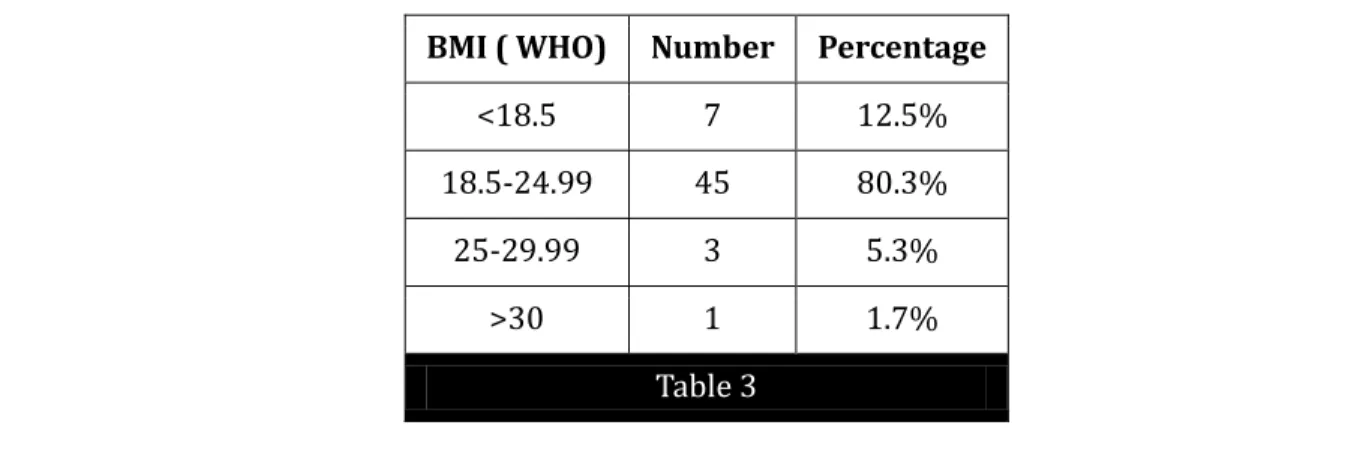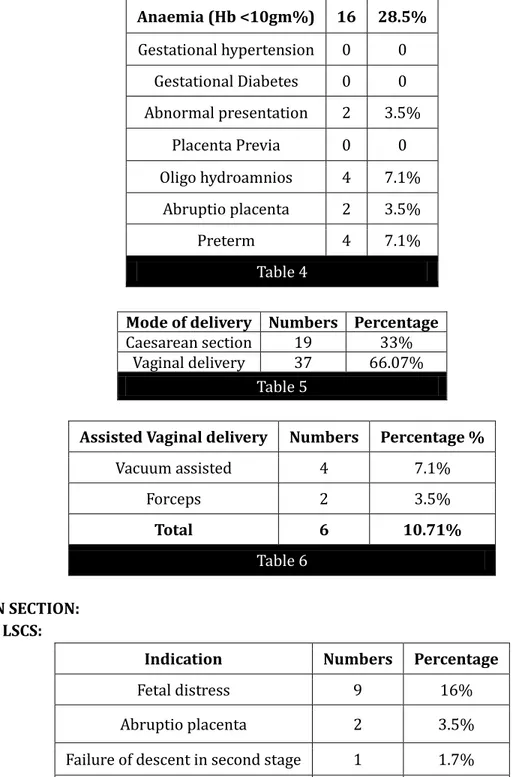J of Evolution of Med and Dent Sci/ eISSN- 2278-4802, pISSN- 2278-4748/ Vol. 4/ Issue 43/ May 28, 2015 Page 7483
OUTCOME OF PREGNANCY IN ADOLOSCENT AGE GROUP
Archana Sudhir1, Victor C. Rasquinha2, Smitha B. Rao3, Rajgopala4HOW TO CITE THIS ARTICLE:
Archana Sudhir, Victor C. Rasquinha, Smitha B. Rao, Rajgopala. Outcome of Pregnancy in Adoloscent Age Group . Journal of Evolution of Medical and Dental Sciences 2015; Vol. 4, Issue 43, May 28; Page: : 7483-7488, DOI: 10.14260/jemds/2015/1086
ABSTRACT: INTRODUCTION: Adolescent pregnancy is a common problem encountered in developing countries like India due to early age of marriage. This was seen in women with lower socioeconomic status. Many studies have shown conflicting results. AIM OF THE STUDY: To study the maternal and fetal effects of adolescent pregnancy. MATERIALS AND METHODS: This is a hospital based retrospective study done in Yenepoya Medical College over a period of 18 months. All patients with age between 10-19 years were included. EXCLUSION CRITERIA: Multiple gestation, patients with chronic diseases like, chronic hypertension and diabetes, congenital heart disease and chronic renal disease. RESULTS: Teenage pregnancies are associated with increased incidence of preterm birth, low birth weight babies, delivery by forceps of vacuum, caesarean section and low APGAR at birth. CONCLUSION: Teenage women are more likely to have anaemia, preterm birth, low birth weight babies, delivery by forceps or vacuum or by caesarean section. Good family support, preconceptional counselling, regular antenatal care may improve the perinatal outcome to some extent.
KEYWORDS: Oligohydramnios, Adolescent, Preterm.
INTRODUCTION: Adolescent is a very vulnerable stage both physically and mentally. Adolescent pregnancy is an important health problem as it often occurs in context of poor social support and maternal well being.(1) Adolescence means a transitional stage of physical and mental human development, involving biological, social and psychological changes, occurs between 10-19 years of age ago according to The World Health Organization (WHO). Pregnancy at this period can put an additional strain on this period. The main contributing factors are earlier onset of puberty and early age of marriage.(1)
Studies have shown that there is increased rate of adverse perinatal outcome with teenage pregnancy, which includes pregnancy induced hypertension, preeclampsia, eclampsia, preterm labour, preterm delivery, low birth weight, SGA, low apgar and neonatal mortality with teenage pregnancies.(2)
AIM OF THE STUDY: To study the maternal and fetal effects of pregnancy in adolescent age group.
MATERIALS AND METHODS: A retrospective hospital based study was carried out in the Department of Obstetrics & Gynaecology of Yenepoya Medical College; a tertiary level health care referral centre in Mangalore, Karnataka over a period of 18months from September 2012 to April 2014.
Inclusion Criteria: All Primigravida with singleton pregnancy aged 10-19 years, gelivering in our hospital within this time period.
J of Evolution of Med and Dent Sci/ eISSN- 2278-4802, pISSN- 2278-4748/ Vol. 4/ Issue 43/ May 28, 2015 Page 7484
All selected outcome variables were recorded on printed proforma’s in the hospital & the data
was analysed. Findings were analyzed with special emphasis on patient's age, body mass index, maternal outcome & fetal outcome.
Selected outcome variables included: maternal age, gestational age, antenatal medical complications like anaemia, gestational hypertension, gestational diabetes, amniotic fluid index, mode of delivery, birth weight, congenital anomaly, apgar score & perinatal mortality. Results were analyzed using percentage & proportion.
RESULT: 56 teenage deliveries were there in our hospital during this study period. Most of them were 19 years old (89%), 8.9% were 18 years old, 1.7% 16 years old.
MATERNAL AGE NUMBERS PERCENTAGE
19 50 89%
18 5 8.9%
17 0 0
16 1 1.7%
Table 1
Among the patients who were studied most of them delivered at term (92.8%), preterm (7.1%). This suggests that there is slight increase in the incidence of preterm deliveries with decreased maternal age.
Gestational age Numbers Percentage
28-34 weeks 4 7.1%
34-37 weeks 0 0
37-42 weeks 52 92.8%
Table 2
Table 3. Shows that most of the adolescent age group in the study had normal body mass index.
BMI ( WHO) Number Percentage
<18.5 7 12.5%
18.5-24.99 45 80.3%
25-29.99 3 5.3%
>30 1 1.7%
J of Evolution of Med and Dent Sci/ eISSN- 2278-4802, pISSN- 2278-4748/ Vol. 4/ Issue 43/ May 28, 2015 Page 7485
Table 4 shows that 28.5% of the study group have anaemia. This table also shows that there is no increased incidence of gestational diabetes, gestational hypertension or placenta previa in adolescent age group. Abnormal presentation included 1 breech and 1 transverse lie. Study shows that there is slight increase in the incidence of oligohydramnios and preterm birth.
Anaemia (Hb <10gm%) 16 28.5%
Gestational hypertension 0 0
Gestational Diabetes 0 0
Abnormal presentation 2 3.5%
Placenta Previa 0 0
Oligo hydroamnios 4 7.1%
Abruptio placenta 2 3.5%
Preterm 4 7.1%
Table 4
Mode of delivery Numbers Percentage
Caesarean section 19 33%
Vaginal delivery 37 66.07%
Table 5
Assisted Vaginal delivery Numbers Percentage %
Vacuum assisted 4 7.1%
Forceps 2 3.5%
Total 6 10.71%
Table 6
CESAREAN SECTION: ELECTIVE LSCS:
Indication Numbers Percentage
Fetal distress 9 16%
Abruptio placenta 2 3.5%
Failure of descent in second stage 1 1.7%
Obstructed labour 1 1.7%
Total 13 23%
J of Evolution of Med and Dent Sci/ eISSN- 2278-4802, pISSN- 2278-4748/ Vol. 4/ Issue 43/ May 28, 2015 Page 7486 ELECTIVE LSCS:
Indication Numbers Percentage
Failed induction 3 5.3%
Cephalo-pelvic disproportion 1 1.7%
Transverse lie 1 1.7%
Previous LSCS 1 1.7%
Total 6 10.7%
Table 8
Table 5,6,7 and 8 are related to the mode of delivery. This shows that a significant number of them underwent caesarean section i e 33%. Most of the caesareans were emergency LCSC. (23%), Most common indication being fetal distress , which constitutes 47.36% of all LSCS. Out of the 19 LSCS, 68.4% were done for an emergency indication. This data concludes that there is significant increase in the incidence of emergency LSCS in pregnancies with decreased maternal age. Out of the 43 vaginal deliveries, 74.41%of them had full term vaginal delivery. 13.9%were assisted (Vacuum /Forceps), 9.3%were preterm.
Together this data suggests that there is increased incidence of operative intervention in case of adolescent pregnancies.
Birth weight Number Percentage
<2. kg 7 12.5%
2.5-3.5 kg 46 82%
>3.5 kg 3 5.3%
Table 9
APGAR <8 in 1 min <9 in 5 min
Numbers 9 7
Percentage 16% 12.5%
Table 10
Table 9 and 10 shows neonatal parameters, that is birth weight and Apgar.
This study showed that 12.5% were low birth weight babies. 16% of the babies had low apgar at birth resulting in NICU admission. Perinatal mortality studied in this group showed that there was 1.7% stillborn and 1.7% neonatal death.
J of Evolution of Med and Dent Sci/ eISSN- 2278-4802, pISSN- 2278-4748/ Vol. 4/ Issue 43/ May 28, 2015 Page 7487 Anaemia 28.5% 18.1% sulaiman et al[1]
10% ekachai et al[5]
Preterm 7.1% 24.3% sulaiman et al[1] 27.45% yasmin et al[3] Oligo
hydramnios 7.1% 2.24% yasmin et al[3]
Gestational hypertension nil 0.4% ekachai et al[5] 6.4% kayasatha et al[6] Gestational
diabetes nil 0.3% ekachai et al[5]
Abruptio
placenta 3.5% 0.1%ekachai et al[5]
Caesarean section 33% 19% sulaiman et al 4.1% ttlao et al
Spontaneous vaginal delivery 55.3% 79.4% Ttlao et al 89% Sulaiman et al
Low birth weight 12.5% 16.86% yasmin et al 17.4% ekachai et al
Low Apgar 16% 2.5% ekachai et al
CONCLUSION: Most of the teenagers are found to be anaemic which increases the morbidity, This is mainly due to the low socioeconomic status. Study concludes that teenagers are at an increased risk of operative delivery, low birth weight and low apgar. Our study shows that there is no significant increase in the incidence of gestational hypertension, diabetes or antepartum hemorrhage in adolescent group. Good family support, pre conceptional counselling regular antenatal care may improve the perinatal outcome to some extent.
REFERENCES:
1. S Sulaiman, M. B. , MMed (O&G); S Othman, 2 MBBS, MMed (Family Medicine); N Razali, 1 MBBS, MMed (O&G);, M. J Hassan, et al. (September 2013). "Obstetric and perinatal outcome in teenage pregnancies. " SAJOG Vol. 19( 3): 77-79.
2. Xi Kuan Chen, s. w. w. (2007). "Teenage pregnancy and adverse birth outcomes: a large population based retrospective study. " international journal of epidemiology 36(2): 368-373. 3. Gazala yasmin, a. k. (2014). "Teenage pregnancy - its impact on maternal and fetal outcome. "
international journal of scientific society 1(6): 9-13.
4. Martina Derme(1), E. L. , Giuseppe Vetrano(1), Lisa Carlomagno(1), Vincenzo Aleandri (2013). "obstetricc and perinatal outcomes of teenage pregnant women: a retrospective study." Epidemiology Biostatistics and Public Health 10: 8641-8646.
5. Ekachai kovavisarach (2010). "outcome of teenage pregnancy in rajavithi hospital." Journal of medical association thai 93(1): 1-8.
J of Evolution of Med and Dent Sci/ eISSN- 2278-4802, pISSN- 2278-4748/ Vol. 4/ Issue 43/ May 28, 2015 Page 7488
AUTHORS:
1. Archana Sudhir 2. Victor C. Rasquinha 3. Smitha B. Rao 4. Rajgopala
PARTICULARS OF CONTRIBUTORS:
1. Post Graduate Resident, Department of Obstetrics & Gynaecology, Yenepoya Medical College, Deralakatte, Mangalore. 2. Associate Professor, Department of
Obstetrics & Gynaecology, Yenepoya Medical College, Deralakatte, Mangalore. 3. Assistant Professor, Department of
Obstetrics & Gynaecology, Yenepoya Medical College, Deralakatte, Mangalore.
FINANCIAL OR OTHER
COMPETING INTERESTS: None
4. Professor, Department of Obstetrics & Gynaecology, Yenepoya Medical College, Deralakatte, Mangalore.
NAME ADDRESS EMAIL ID OF THE CORRESPONDING AUTHOR:
Dr. Archana Sudhir, 103, Aysha Residency,
Behind Yenepoya Medical College, University Road,
Deralakatte, Mangalore-575018, Karnataka.
E-mail: richu1989@gmail.com

